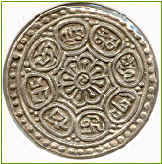|

General Information

I believe the Tibetan Ga-den
Thangka is one of the most attractive coin for a numismatist because of
e.g.;
1. The beauty and differences of all
eight Buddhist Symbols
2. The variations in the location of the Buddhist
Symbols
3. The variations of the symbols in the outer
angles of the petals.
3. The variations in design of e.g. the lotus
flower and presence of spokes
4. The differency in dies
5. The big range of number of dots around both
borders
6. The variations in the size of the inner circel
and the size of the coin itself
7. The
known errors
8. The secrets behind
; the mintplaces
; some markers
; the unknown minted numbers of each variety
9. The commonness and attractive purchase price
in general
Description of the Ga-den Thangka
 
Rhodes class Fii/KM Y13.6
Obverse: An stylised Lotus flower within a
circle surrounded by eight Buddhist Lucky symbols placed in petals.
Reverse: eight petalled flowers surrounded
by an inscriptions broken up into eight mostly oval frames. The inscription in
tibetan reading is; 'Ga-den Pho-dang chhog-le rnam-gyal' with means 'The
gaden palace Victorious on all sides'.

Monetary System
10 Ska (rung) = 1 Sho
(kang),
15 Ska (rung) = 1 Ga-den Tangka
3 Ga-den Thangka
= 1 Indian Rupee
The exchange rate
of the rupee against the Ga-den Thangka varied from time to time. Three Ga-den
Thangkas may be taken as the highest rate and about six as the lowest.
Date
Based on the Tibetan calendar, Tibetan
coins are dated by circles which contains 60 years each. To calculate the
western date you use the following formula.
Western date = ( (Number of Cycles -1) x
60) + number of Year + 1026
For examble 1900 AD = 15 th cycle, 34 th
year
Remark; There is no writen date on the Ga-den
Thangka coin.

|  Hans Sanders (NL)
Hans Sanders (NL)